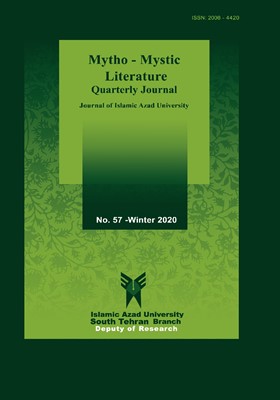The Lunar Symbols in an Iranian Legend
Subject Areas : MythoHakimeh Mojāhedi 1 , Mohammad Rezā Sarfi 2 , Mahmoud Modabberi 3
1 - Ph. D. in Persian Language and Literature, Shahid Bahonar University of Kerman
2 - The Professor of Persian Language and Literature, Shahid Bahonar University of Kerman
3 - The Professor of Persian Language and Literature, Shahid Bahonar University of Kerman
Keywords: Water, Legend, Moon, Lunar symbols, Talisman,
Abstract :
Lunar symbols refer to features that are related to functions and holy manifestations of the moon (as a goddess). These features generally include transformation, adjustment of time, making fate, fertility and rain bearing, revitalization, death and resurrection. Anything or phenomenon that has one or more of these attributes presents a lunar symbol and the moon dominates it. The lunar symbols have also been reflected in Iranian national legends. The legend of "Cheshme Pari", selected from Iranian Legends and Fairy Tales Encyclopedia, covers a collection of lunar symbols. By using descriptive-analytical method, the authors of the present article try to examine the legend of "Cheshme Pari" and to show the trace of worship of moon and water in the mythological beliefs of the Iranian people. Water is the most important symbol and element of the legend; it is pillar of the narrative and is present at all events. Almost all of the functions related to lunar have been used in the legend.
الیاده، میرچا. 1385. رساله در تاریخ ادیان. ترجمۀ جلال ستاری. چ 3. تهران: سروش.
پورداوود، ابراهیم. 1377. یشتها. ج1. چ 1. تهران: اساطیر.
درویشیان، علی اشرف و رضا خندان مهابادی. 1377. فرهنگ افسانههای ایرانی. ج 3. چ1. تهران: کتاب و فرهنگ.
دلاشوـ لوفر. م. 1366. زبان رمزی قصههای پریوار. ترجمۀ جلال ستاری، چ1. تهران: توس.
دوبوکور، مونیک. 1373. رمزهای زنده جان. ترجمۀ جلال ستاری، چ1. تهران: مرکز.
سرکاراتی، بهمن. 1385. سایههای شکار شده، گزیدۀ مقالات فارسی. چ1. تهران: طهوری.
شوالیه، ژان و آلن گربران. 1387. فرهنگ نمادها. ترجمه و تحقیق سودابه فضایلی. چ1. تهران: جیحون.
صمدی، مهرانگیز رجالی. 1367. ماه در ایران، از قدیمترین ایام تا ظهور اسلام. چ1. تهران: علمی و فرهنگی.
فریزر، جیمز جرج. 1383. شاخۀ زرین، پژوهشی در جادو و دین. ترجمۀ کاظم فیروزمند. چ1.تهران: آگاه.
یاحقی، محمّد جعفر. 1389. فرهنگ اساطیر و داستانوارهها در ادبیات فارسی. تهران: فرهنگ معاصر.
_||_References
Chevalier, Jean & Alain Gheerbrant. (2008/1387SH). Farhang-e namād-hā (Dictionnaire des symbols). Tr. by Sūdābe Fazāyelī. 1st ed. Tehrān: Jeyhūn.
Darvīšīyān, Alī Ašraf & Rezā Xandān Mahābādī. (1998/1377SH). Farhang-e afsāne-hā-ye mardom-e īrān. 3rd vol. 1st ed. Tehrān: Ketāb va Farhang.
Eliāde, Mircea . (2006/1385SH). Resāle dar tārīx-e adyān (Traite d'histoire des religions). Tr. by Jalāl Sattārī. 3rd ed. Tehrān: Sorūš.
Frazer, James George. (2004/1383SH). Šaxe-ye zarrīn (The golden bough: a study in religion and magic). Tr. by Kāzem Fīrūzmand. 1st ed. Tehrān: Āgāh.
Loeffler-Delachaus, Marguerite. (1987/1366SH). Zabān-e ramzī-ye qesse-hā-ye parīvār (Le symbolisme des contes de fees). Tr. by Jalāl Sattārī. 1st ed. Tehrān: Tūs.
Monique, De Beaucorps. (1994/1373SH). Ramz-hā-ye zende-ye jān (Les symboles vivants). Tr. by Jalāl Sattārī. 1st ed. Tehrān: Markaz.
Pūrdāvūd, Ebrāhīm. (1998/1377SH). Yašt-hā. 1st Vol. Tehrān: Asātīr.
Samadī Rejālī, Mehrangīz. (1988/1367SH). Māh dar īrān, az qadīmī-tarīn ayyām tā zohūr-e eslām. 1st ed. Tehrān: Elmī va Farhangī.
Sarkārātī, Bahman. (2006/1385SH). Sāye-hā-ye šekār-šode. 1st ed. Tehrān: Tahūrī.
Yāhaqqī, Mohammad Ja’far. (2010/1389SH). Farhang-e asātīr va ešārāt-e dāstānī dar adabīyāt-e fārsī. Tehrān: Farhang-e Mo’āser.


